The role of the Th1 transcription factor T-bet in a mouse model of immune-mediated bone-marrow failure
- PMID: 19903901
- PMCID: PMC2810980
- DOI: 10.1182/blood-2009-03-211383
The role of the Th1 transcription factor T-bet in a mouse model of immune-mediated bone-marrow failure
Abstract
The transcription factor T-bet is a key regulator of type 1 immune responses. We examined the role of T-bet in an animal model of immune-mediated bone marrow (BM) failure using mice carrying a germline T-bet gene deletion (T-bet(-/-)). In comparison with normal C57BL6 (B6) control mice, T-bet(-/-) mice had normal cellular composition in lymphohematopoietic tissues, but T-bet(-/-) lymphocytes were functionally defective. Infusion of 5 x 10(6) T-bet(-/-) lymph node (LN) cells into sublethally irradiated, major histocompatibility complex-mismatched CByB6F1 (F1) recipients failed to induce the severe marrow hypoplasia and fatal pancytopenia that is produced by injection of similar numbers of B6 LN cells. Increasing T-bet(-/-) LN-cell dose to 10 to 23 x 10(6) per recipient led to only mild hematopoietic deficiency. Recipients of T-bet(-/-) LN cells had no expansion in T cells or interferon-gamma-producing T cells but showed a significant increase in Lin(-)Sca1(+)CD117(+)CD34(-) BM cells. Plasma transforming growth factor-beta and interleukin-17 concentrations were increased in T-bet(-/-) LN-cell recipients, possibly a compensatory up-regulation of the Th17 immune response. Continuous infusion of interferon-gamma resulted in hematopoietic suppression but did not cause T-bet(-/-) LN-cell expansion or BM destruction. Our data provided fresh evidence demonstrating a critical role of T-bet in immune-mediated BM failure.
Figures
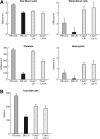
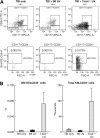
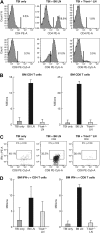
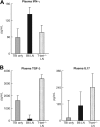
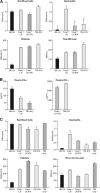
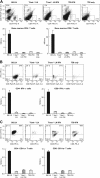
Similar articles
-
Role of perforin-mediated cell apoptosis in murine models of infusion-induced bone marrow failure.Exp Hematol. 2009 Apr;37(4):477-86. doi: 10.1016/j.exphem.2008.12.001. Epub 2009 Feb 12. Exp Hematol. 2009. PMID: 19216020 Free PMC article.
-
Macrophage TNF-α licenses donor T cells in murine bone marrow failure and can be implicated in human aplastic anemia.Blood. 2018 Dec 27;132(26):2730-2743. doi: 10.1182/blood-2018-05-844928. Epub 2018 Oct 25. Blood. 2018. PMID: 30361263 Free PMC article.
-
Lymphocytes with aberrant expression of Fas or Fas ligand attenuate immune bone marrow failure in a mouse model.J Immunol. 2009 Mar 15;182(6):3414-22. doi: 10.4049/jimmunol.0801430. J Immunol. 2009. PMID: 19265119 Free PMC article.
-
More than just a T-box: the role of T-bet as a possible biomarker and therapeutic target in autoimmune diseases.Immunotherapy. 2011 Mar;3(3):435-41. doi: 10.2217/imt.10.111. Immunotherapy. 2011. PMID: 21395384 Free PMC article. Review.
-
T-bet as a key regulator of mucosal immunity.Immunology. 2016 Apr;147(4):367-76. doi: 10.1111/imm.12575. Epub 2016 Feb 23. Immunology. 2016. PMID: 26726991 Free PMC article. Review.
Cited by
-
Th17 immune responses contribute to the pathophysiology of aplastic anemia.Blood. 2010 Nov 18;116(20):4175-84. doi: 10.1182/blood-2010-01-266098. Epub 2010 Aug 23. Blood. 2010. PMID: 20733158 Free PMC article.
-
When inflammatory stressors dramatically change, disease phenotypes may transform between autoimmune hematopoietic failure and myeloid neoplasms.Front Immunol. 2024 Feb 15;15:1339971. doi: 10.3389/fimmu.2024.1339971. eCollection 2024. Front Immunol. 2024. PMID: 38426096 Free PMC article. Review.
-
[Tetramethylpyrazine promotes bone marrow repair in a C57 mouse model of X-rayinduced immune-mediated bone marrow failure].Nan Fang Yi Ke Da Xue Xue Bao. 2019 Aug 30;39(8):957-963. doi: 10.12122/j.issn.1673-4254.2019.08.13. Nan Fang Yi Ke Da Xue Xue Bao. 2019. PMID: 31511217 Free PMC article. Chinese.
-
Hematopoietic stem cell development, aging and functional failure.Int J Hematol. 2011 Jul;94(1):3-10. doi: 10.1007/s12185-011-0856-1. Epub 2011 Apr 27. Int J Hematol. 2011. PMID: 21523336 Review.
-
NOTCH signaling in immune-mediated bone marrow failure of aplastic anemia.Rare Dis. 2013 Nov 6;1:e26764. doi: 10.4161/rdis.26764. eCollection 2013. Rare Dis. 2013. PMID: 25003012 Free PMC article.
References
-
- Kojima S, Frickhofen N, Deeg HJ, et al. Aplastic anemia. Int J Hematol. 2005;82(5):408–411. - PubMed
-
- Nagy SM, Jr, Fisher JJ. Aplastic anemia and immunosuppression [abstract]. JAMA. 2003;290(2):193. - PubMed
-
- Abdelkefi A, Ben OT, Ladeb S, et al. Bone marrow transplantation for patients with acquired severe aplastic anemia using cyclophosphamide and antithymocyte globulin: the experience from a single center. Hematol J. 2003;4(3):208–213. - PubMed
-
- Maciejewski JP, Hibbs JR, Anderson S, Katevas P, Young NS. Bone marrow and peripheral blood lymphocyte phenotype in patients with bone marrow failure. Exp Hematol. 1994;22(11):1102–1110. - PubMed
MeSH terms
Substances
LinkOut - more resources
Full Text Sources
Medical

